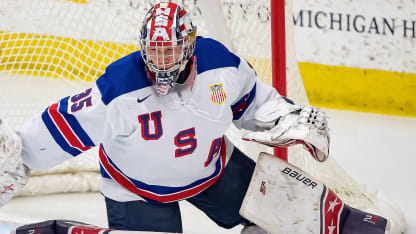It includes comprehensive coverage of the United States National Junior Team, which will play the first of four preliminary-round games in Group B against Slovakia on Sunday (9:30 p.m. ET; NHLN). The United States also will play Switzerland (Dec. 28), Sweden (Dec. 29) and Russia (Dec. 31). The playoff round begins Jan. 2.
Longtime NCAA hockey analyst Dave Starman, who will handle the broadcasts along with Stephen Nelson and Jon Rosen, will give his three keys to victory for the United States before each of its games during the 11-day tournament.
"As the tourney opens, the United States gets a good matchup against the Slovaks, who on any given night in any tourney year can be a pest to play," Starman said. "That being said, the early game can be a good wake-up call for] the United States. It's not a guaranteed win though. Slovakia won't match the U.S. depth, but you want a hard Game 1 to set the tone and show the first-timers that this is big-boy hockey."
Here are Starman's 3 keys to victory for the United States against Slovakia:
**1. Just play the game**
"No one ever won or lost the gold medal in Game 1, but you get a lot of nervous energy coming into it and a lot of adrenaline, so mistakes can happen, and it can be a hard game to win as a slight favorite. Don't chase the game, keep shifts short, no YouTube highlight-reel type attempts. Just play the game. Flush the bad shifts out, reset quick, set the tone for the rest of the tourney. Not every game is a masterpiece, but it is a learning experience and to win here, you need to learn quick."
**2. Defensive zone face-offs**
"Thanks to Brian Daccord of StopItGoaltending.com for this nugget:
[Drew Commesso
has a 45 percent rebound retention rate, which means he holds onto one of every two shots taken. Usually, 33 percent is pretty good; 45 percent is unreal. That means not a lot of chaos in the defensive zone grade, a scoring area for opponents, but it also means the possibility for a lot of defensive zone draws. Feel free to watch my presentation at
'The Coaches Site'
on defensive zone faceoff wins and clearing options. Getting coordinated in this area is a big step to winning a lot of close games against good teams."
3. Unlocking combinations
"In my coaching career, I had a lot of lines that looked great in practice, but not in games. There will be players who played together in major-junior or elsewhere that are teammates here and there is a tendency to put them together due to familiarity. Sometimes that works, sometimes it doesn't. Game 1 and Game 2 are really good to start to see who might click together."
---
Listen: New episode of NHL Draft Class

